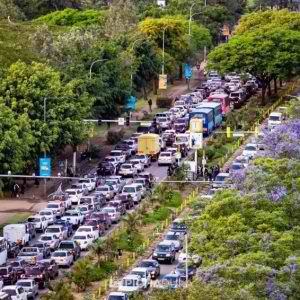[bctt tweet="Most cities have been designed around mobility for cars, and it is high time we change this and start designing cities around human mobility." username="QaziniKenya"]
According to the website numbeo.com, a crowd-sourced global database providing information of the quality of life in cities around the world, pre-COVID-19, Nairobi ranked as the third most traffic-congested city in the world after Kolkata in India and Colombo in Sri Lanka. On average, Nairobians would spend 58.13 minutes per day in traffic, Kolkatans an average of 61.79 and people in Colombo 59.60 minutes.
Several attempts have been made by the government to alleviate the problem of traffic congestion within Kenya’s capital. None have succeeded. Most recently, in early 2019, the government announced that Wednesdays and Saturdays would be car-free days in Nairobi’s Central Business District. On these days, private cars and public-service vehicles would not be allowed within the city centre. However, there was a public outcry because alternative options to reach the business district were still not in place. As a result, the car-free days were cancelled.
A Global Problem
While cars are a convenient mode of transport, offering motorists a number of benefits, vehicle emissions are one of the main sources of outdoor air pollution around the globe. The World Car Free Day celebrated every 22nd September, aims to take the heat off the planet for just one day by encouraging people to be less dependent on their cars and try alternatives. The day is used to highlight the numerous benefits of going car-free to citizens, including reduced air pollution and the promotion of walking and cycling in a safer environment.
“Most cities have been designed around mobility for cars, and it is high time we change this and start designing cities around human mobility,” says Rob de Jong, Head of UN Environment’s Air Quality and Mobility Unit.
An Opportunity
While car-free days present a massive opportunity for cities to acknowledge the problems associated with our current preferred modes of transportation, it was the Coronavirus pandemic that ultimately opened our eyes to the fact that we can and must course correct.
The virus resulted in empty streets all over the world, and for the first time, many of us got a feel of how our cities might look, feel, and sound like without cars. Hot on the heels of the opportunity COVID-19 presented, European cities have started reassessing their mobility policies.
An option to limit car usage is shared mobility, where people use pool cars. Whereas this might seem like a strange option at first in the current situation, there are some advantages to it. Sharing a car with strangers can indeed be weird, and there are high risks to spread the virus more rapidly, but it can be a decent solution within a community in the longterm. People spend more time with those in their bubbles, creating strong feelings of togetherness which will strengthen more by commuting to work together.
Apart from sharing vehicles, there are plenty of other options to counter the abundance of cars. Many people have gotten used to remote working, which means less commuting and less demand for mobility. Flexible workspaces allow employees to work in a professional environment without unnecessary commuting, and mobility hubs optimize travelling via shared or public transport.
Whereas there has been an improvement in air quality due to a reduction in pollution, the fear of getting in touch with other people might result in using more private cars, eventually creating more pollution as a consequence. It is vital to limit this because intensified air pollution during a respiratory pandemic will deteriorate the situation; especially since there is a link between exposure to PM 2.5 air pollution (emitted by Diesel engines) and a higher death rate through COVID-19.
Several European cities, big and small, have started to reform their streets and implement new rules to benefit road users. Milan, the epicentre of the outburst in Europe, used the past weeks to reform its streets by creating bigger bicycle and pedestrian lanes. The fashion capital of the world was built in the Middle Ages and is very compact with an intersection of 15km. Streets are designed for pedestrians and users of light vehicles, not for cars. Some of these streets are now free of cars, whereas some have speed limits of 30km/h.
On top of that, the city is committed to sustainable transport via electric sharing steps. These are user-friendly and use 100% durable energy. They are convenient for tourists to explore the city, but the chief purpose is to positively contribute to the daily life of citizens. The steps are cleaner than cars, take up less space, do not make noise and are better for the air quality. Meanwhile, users do not have to worry about the high costs and parking frustrations that come with owning a car.
Apart from the usage and its advantages, the electric steps also create work employment via local reparations. However, the electronic steps do not want to ban cars totally out of Milan. Fewer cars will mean fewer traffic jams and more accessible parking spots.
The steps try to be a reliable and trustworthy alternative to cars, continually aiming to improve via A/B testing to be able to adapt to the user, rather than to impose itself. After all, it is an aid to citizens and not a tool for tourists.
Other cities focus on bike safety. They have created bigger pedestrian pavements and turned entire streets into cycling zones which are safer, more accessible and easier to use. These are red streets with logos all over which makes it very clear that they are cycling streets. Cars are still allowed to drive here, but they are not allowed to overtake cyclists, and there is a speed limit of 30km/h. Bicycle riders and pedestrians are separated, making it safer, and clearer for both parties. Every car needs to adapt to the road behaviour of cyclists and by using streets especially designed for bikes, they might realize that it is easier and faster to move around in a city, hopefully resulting in a change of attitude.
Shops also benefit because their surroundings are safer to clients, ensuring a more relaxed and pleasing shopping experience. The Shop&Go system allows cars to park in front of shops for up to 30 minutes, allowing everyone to shop comfortably, even less mobile among us.
Can It Work in Nairobi?
The larger problem that needs to be addressed is the quality of our lives in urban areas. The levels of pollution, traffic congestion and the resulting impact it has on our mental well being and sedentary lifestyles are a major cause for concern. The concepts outlined above focus on prioritizing light vehicles and pedestrians in combination with mobility hubs outside town. They work to improve the flow of movement, resulting in smoother traffic and cleaner air within. On top of that, the new means of transportation generate extra work opportunities for local people. In principle, the introduction of car-free days for Kenya's metropolis was noble the idea to start with. It fell short on execution. Closer to home, Rwanda's capital, Kigali and Ethiopia's Addis Ababa have both managed to successfully implement car-free days. With the right political will, there is no reason why Nairobi can't do the same.





